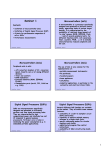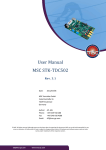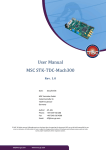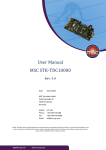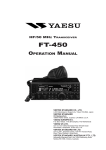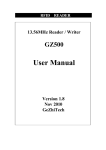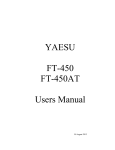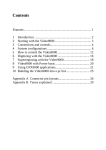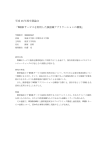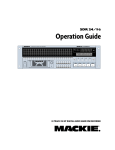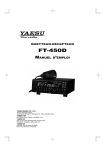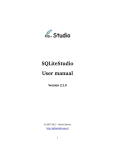Download User manual MSC TDC10000, Rev. 2.3
Transcript
User Manual MSC TDC10000 Version: 2.3 Date: 2010/01/13 MSC Vertriebs GmbH Industriestraße 16 76297 Stutensee Germany Author: Phone: Fax: Email: UW/AP +49 7249 910 205 +49 7249 910 268 [email protected] © MSC. All rights reserved. Although great care has been taken in preparing this document, MSC can not be held responsible for any errors or omissions. All information in here is subject to change without notice. All hardware and software names used are trade names and/or trademarks of the respective owners. [email protected] www.msc-ge.com User Manual - MSC TDC10000 MSC Page 2 of 47 Contents 1 INTRODUCTION ...................................................................................................................... 4 2 FEATURES ................................................................................................................................ 5 3 BLOCK DIAGRAM .................................................................................................................. 6 4 PACKAGE AND PIN CONFIGURATION ............................................................................ 7 4.1 4.2 5 PACKAGE .............................................................................................................................. 7 PIN CONFIGURATION ............................................................................................................. 7 MEASURING PROCEDURE ................................................................................................ 10 5.1 TIME DIFFERENCE MEASUREMENT ..................................................................................... 10 5.2 GENERATING CALIBRATION VALUES .................................................................................. 11 5.3 M0-MEASUREMENT ............................................................................................................ 12 5.4 MEASUREMENT RANGES ..................................................................................................... 12 5.4.1 Measurement Procedure in Measurement Range I ........................................................ 12 5.4.2 Measurement Procedure in Measurement Range II ....................................................... 13 5.5 MEASUREMENT MODES ...................................................................................................... 14 6 FUNCTIONAL DESCRIPTION ............................................................................................ 16 6.1 ON-CHIP OSCILLATOR ........................................................................................................ 16 6.2 CALIBRATION CLOCK DIVIDER ........................................................................................... 16 6.3 MEASUREMENT CHANNELS................................................................................................. 17 6.3.1 Input Unit ....................................................................................................................... 18 6.3.2 Retrigger Unit ................................................................................................................ 18 6.3.3 Auto Noise Unit ............................................................................................................. 19 6.3.4 Delay-Line ..................................................................................................................... 20 6.3.5 Measuring Core .............................................................................................................. 20 6.3.6 Precounter ...................................................................................................................... 20 6.4 ARITHMETICAL LOGIC UNIT (ALU) .................................................................................... 20 6.5 RESOLUTION-LOCK UNIT .................................................................................................... 21 6.5.1 Principle Function .......................................................................................................... 21 6.5.2 Operating Sequence ....................................................................................................... 21 6.5.3 Resolution-Lock Unit Registers ..................................................................................... 23 6.5.3.1 LOCKMOD Register ............................................................................................. 23 6.5.3.2 LOCKREG Register .............................................................................................. 23 6.5.4 External Analog Circuit ................................................................................................. 23 6.5.5 Power Consumption ....................................................................................................... 23 6.6 TDC REGISTERS ................................................................................................................. 24 6.6.1 Instruction Register ........................................................................................................ 24 6.6.2 Mode Registers .............................................................................................................. 24 6.6.3 Global Registers ............................................................................................................. 24 6.6.4 Offset Registers .............................................................................................................. 24 6.6.5 Status Register................................................................................................................ 24 6.6.6 M0-Registers .................................................................................................................. 24 TDC10000RefManEngV23.doc [email protected] Version: 2.3 www.msc-ge.com Author: UW/AP User Manual - MSC TDC10000 MSC Page 3 of 47 6.7 RESULT-FIFOS ................................................................................................................... 25 6.8 PROCESSOR INTERFACE....................................................................................................... 25 6.8.1 Data- and Control Lines ................................................................................................. 26 6.8.1.1 Overview ................................................................................................................ 26 6.8.1.2 Timing Diagrams ................................................................................................... 26 6.8.2 Status Flags .................................................................................................................... 27 6.9 DAISY CHAIN INTERFACE ................................................................................................... 28 6.9.1 Daisy Chain Configuration Cycle and Chip Number Assignment ................................ 28 6.9.2 Daisy Chain Read-Mode ................................................................................................ 29 6.9.3 Processorless Mode ........................................................................................................ 30 7 PROGRAMMING OF THE TDC10000 ................................................................................ 31 7.1 EXECUTION OF INSTRUCTIONS ............................................................................................ 31 7.1.1 List of Instructions (Opcodes)........................................................................................ 33 7.1.2 Description of the Instructions ....................................................................................... 34 7.2 READ REGISTERS AND DATA FORMAT OF MEASUREMENT RESULTS .................................. 36 7.3 WRITE REGISTERS ............................................................................................................... 37 7.3.1 Mode Registers MODREG0/1 ....................................................................................... 37 7.3.2 Global Register GLOBREG0......................................................................................... 38 7.3.3 Global Register GLOBREG1......................................................................................... 39 7.3.4 Offset Registers OFFSET0/1 ......................................................................................... 39 7.3.5 LOCKMOD Register ..................................................................................................... 40 7.3.6 LOCKREG Register ...................................................................................................... 40 8 APPENDIX ............................................................................................................................... 41 8.1 ELECTRICAL SPECIFICATIONS ............................................................................................. 41 8.1.1 Recommended Operating Conditions ............................................................................ 41 8.1.2 Absolute Maximum Ratings .......................................................................................... 41 8.2 ACCURACY OF MEASUREMENT ........................................................................................... 42 8.2.1 Measurements in Measurement Mode 0 (Default Mode) .............................................. 42 8.2.2 Measuring with highest possible Accuracy ................................................................... 42 8.3 MEASUREMENTS WITH RESOLUTION-LOCK ........................................................................ 42 8.3.1 Example of Activating the Resolution-Lock Unit ......................................................... 43 8.4 DEAD TIMES ....................................................................................................................... 43 8.5 BEHAVIOR OF THE TDC AT SYSERR ................................................................................. 44 8.6 POWER-ON CHARACTERISTICS ........................................................................................... 44 8.7 APPLICATION NOTES ........................................................................................................... 45 8.7.1 Standard Wiring of the TDC10000 ................................................................................ 45 8.7.2 Wiring for Measurement Mode 0................................................................................... 46 8.7.3 Wiring for Measurement Mode 1................................................................................... 47 TDC10000RefManEngV23.doc [email protected] Version: 2.3 www.msc-ge.com Author: UW/AP User Manual - MSC TDC10000 MSC Page 4 of 47 1 Introduction MSC Vertriebs GmbH has many years of experience in the development of high precision Time to Digital Converters (TDCs). MSC´s first TDC was developed in 1990 and implemented in a costeffective Gate Array technology. Similar to the terms ADC, DAC, etc., MSC established the term TDC (Time to digital Converter). This manual describes the TDC10000, which is implemented in a 0,8µm-CMOS-process technology featuring 2.7V - 5V operation. The chip is delivered in a QFP80 0,8mm fine pitch package. Supplied with 5V the TDC10000 achieves a typical resolution of 60ps. This resolution cannot be achieved using conventional time measurement components. The multi-channel function of the TDC10000 allows simultaneous measurement of time differences on two independent measurement channels. The integrated measurement principle - together with the technology used - allows high-precision time difference measurement at low power consumption. The integration of the TDC10000 in battery-powered applications has become to a common procedure. The TDC10000 is perfectly suited for measurement of time differences. Applications like distance measurement using laser, phase measurement, ultrasonic positioning, temperature measurement, etc. have been implemented successfully with our TDCs many times. Please contact us! We are keen on satisfying your wishes. TDC10000RefManEngV23.doc [email protected] Version: 2.3 www.msc-ge.com Author: UW/AP User Manual - MSC TDC10000 MSC Page 5 of 47 2 Features Channels: two independent channels, each with one Start- and one Stop-input, programmable edge-sensitivity of the inputs, retriggerable Start-inputs Resolution (5V, typ): 60ps Measurement ranges: (5V, typ) range I: short time measurement: 4ns - 6µs range II: long time measurement: 500ns - 8ms *) Measurement modes: 4 Calibration clock: external oscillator clock: 500 kHz - 10 MHz, internal programmable clock divider Calibration measurement: automatically after time measurement or stand-alone Voltage range: 2.7V - 5.5V Temperature range: -40°C - 85°C Processor interface: 8/16 bit selectable, status flags for interrupt generation, daisy chain for cascading of up to 31 TDCs Internal memory: FIFO for up to 4 measurement values per channel Configuration: software- and hardware configurable Measurement improvement: Auto Noise Unit Resolution stabilisation: Resolution-Lock Unit Package: PQFP80 with 0.8 mm pitch *) Measurement range depends on period of calibration clock TDC10000RefManEngV23.doc [email protected] Version: 2.3 www.msc-ge.com Author: UW/AP User Manual - MSC TDC10000 MSC Page 6 of 47 3 Block Diagram ENA0 STOINH0 NOPROC SPEED µPinterface START0 STOP0 FIFO chan. 0 OSZ CALCLK ENOSZ SYSERR CALM READY0 READY1 VALID0 VALID1 channel 0 on-chip oscillator clockdivider ALU BUSDIR FIFO chan. 1 CALCLKI D[15:0] channel 1 START1 STOP1 RD WR CS TDC registers BUS816 PURES resolutionlock unit ENA1 daisychaininterface TOKIN[1:0] TOKOUT[1:0] STOINH1 CLKR PHASE TH RLOCKON WAIT Figure 3.1: TDC10000 Block Diagram The TDC offers two independent measurement channels 0 and 1 for time measurement between the rising/falling edge of a signal at the start-input and the rising/falling edge of a signal at the stop-input with a typical resolution of 60ps (5V, 25°C). The measured values are processed within the ALU (Arithmetic Logical Unit). Up to four measurement values can be stored in the channel’s Result-FIFO and read out via the processor interface. The configuration of the TDC as well as the selection of the measurement mode and range is done by writing the TDC-registers via the processor interface. Status information can be accessed by reading the TDC registers. The resolution-lock unit is used for stabilisation the TDC’s resolution. The daisy chain interface allows cascading of up to 31 TDCs. The calibration clock, necessary for the calibration of the measurement values, has to be supplied by an external oscillator clock at the input CALCLK. The calibration clock is divided by the internal clock divider. TDC10000RefManEngV23.doc [email protected] Version: 2.3 www.msc-ge.com Author: UW/AP User Manual - MSC TDC10000 MSC Page 7 of 47 4 Package and Pin Configuration 4.1 Package 64 65 41 40 TDC10000 PQFP80 Top View 80 1 25 24 Figure 4.1: Package Dimensions (in mm) 4.2 Pin Configuration Table 4.1 shows the TDC’s pin configuration. Pin No. Pin name 5, 11, 20, 25, 33, VDD 51, 53, 73, 80 4, 8, 12, 13, 21, VSS 26, 29, 32, 39, 41, 50, 52, 54, 64, 72, 76, 79 TDC10000RefManEngV23.doc [email protected] I/O - Function Supply voltage - Ground Version: 2.3 www.msc-ge.com Author: UW/AP User Manual - MSC TDC10000 MSC Pin No. 3, 22, 65 1 2 6 Pin name START0 STOP0 ENOSZ I/O In In In 7 PHASE 9 10 14 OSZ CALCLK TH Out, Slew Rate, 4mA Out In In 15 16 CLKR In RLOCKON In 17 INHMD In 18 STOINH0 In 19 STOINH1 In 23 24 27 START1 STOP1 ENA1 In In In 28 BUS816 In 30 31 34 WR RD SPEED In In In 35 36 37 38 CS TOKIN0 TOKIN1 NOPROC In In In In 40 WAIT 42 43 44 D0 D1 D2 Out, Open Drain, 8mA Bidi, 8mA Bidi, 8mA Bidi, 8mA TDC10000RefManEngV23.doc [email protected] Page 8 of 47 Function Unconnected Start-input channel 0 Stop-input channel 0 Enable calibration clock-input: 0: CALCLK-input enabled, can be disabled/enabled by software 1: CALCLK-input disabled, cannot be enabled by software PLL phase discriminator output Inverted output of the on-chip oscillators Calibration clock-input: 500 kHz - 10 MHz Track/hold selection for PLL: 0: Track-Mode (default) 1: Hold-Mode Reference clock-input for PLL (default = 0) Resolution-lock unit: 0: off (default) 1: on Automatic M0-measurement: 0: off 1: on (default) Stop inhibit channel 0: 0: STOP0-input enabled 1: STOP0-input disabled Stop inhibit channel 1: 0: STOP1-input enabled 1: STOP1-input disabled Start-input channel 1 Stop-input channel 1 Enable channel 1: 0: channel 1 disabled, cannot be enabled by software 1: channel 1 enabled, can be disabled/enabled by software Processor interface: 0: 16-bit data bus 1: 8-bit data bus Write strobe (low active) Read strobe (low active) ALU-speed: 0: fast (default) 1: slow Chip select (low active) Token-input 0 Token-input 1 Processorless mode: 0: off (default) 1: on WAIT-output for daisy chain read-sequence Bit0 data bus Bit1 data bus Bit2 data bus Version: 2.3 www.msc-ge.com Author: UW/AP User Manual - MSC TDC10000 MSC Page 9 of 47 Pin No. 45 46 47 48 49 55 56 57 58 59 60 61 62 63 Pin name D3 D4 D5 D6 D7 D8 D9 D10 D11 D12 D13 D14 D15 BUSDIR I/O Bidi, 8mA Bidi, 8mA Bidi, 8mA Bidi, 8mA Bidi, 8mA Bidi, 8mA Bidi, 8mA Bidi, 8mA Bidi, 8mA Bidi, 8mA Bidi, 8mA Bidi, 8mA Bidi, 8mA Out, OpenDrain, 8mA Function Bit3 data bus Bit4 data bus Bit5 data bus Bit6 data bus Bit7 data bus Bit8 data bus Bit9 data bus Bit10 data bus Bit11 data bus Bit12 data bus Bit13 data bus Bit14 data bus Bit15 data bus Bus direction indicator: 0: when RDN = 0 (data direction is Out), HiZ: else (data direction is In), pull-up resistor necessary Token-output 1 66 TOKOUT1 67 TOKOUT0 68 CALM 69 READY0 70 READY1 71 SYSERR 74 VALID0 75 VALID1 77 78 PURES ENA0 Out, HighSpeed, 4mA Out, High- Token-output 0 Speed, 4mA Out, 4mA 0: at least one measurement is running at the moment 1: no measurement is running at the moment Out, 4mA 0: channel 0 not ready for measurement 1: channel 0 ready for measurement Out, 4mA 0: channel 1 not ready for measurement 1: channel 1 ready for measurement Out, 4mA 0: TDC ok 1: overflow error (channel independent) Out, 4mA 0: channel 0 has no valid measurement results for readout 1: channel 0 has valid measurement results for readout Out, 4mA 0: channel 1 has no valid measurement results for readout 1: channel 1 has valid measurement results for readout In Power-on reset (high active) In Enable channel 0: 0: channel 0 disabled, cannot be enabled by software 1: channel 0 enabled, can be disabled/enabled by software Remarks: Connect all unused inputs to GND. Data bus DATA[15:0] is not allowed to float: please pull up or down (with e.g. 10k ). Do not connect unused outputs. All inputs are TTL. Table 4.1: Pin Description TDC10000RefManEngV23.doc [email protected] Version: 2.3 www.msc-ge.com Author: UW/AP User Manual - MSC TDC10000 MSC Page 10 of 47 5 Measuring Procedure The TDC10000 provides two identical measurement channels, each with a typical resolution of 60ps at 5V and 25°C. The figures of the user manual always refer to channel 0, however they apply equally well to channel 1. 5.1 Time Difference Measurement As shown in Figure 5.1, per channel one edge sensitive start- and one edge sensitive stop-input are used for measuring the time difference tVAL. The time measurement in the measuring core of the respective channel is started by a start-signal and ended by a stop-signal. The internal ALU calculates the measurement value VAL which is stored in the Result-FIFO of the appropriate channel. TDC 10000 Core START ALU FIFO VAL STOP tVAL CALCLK Figure 5.1: Time Difference Measurement The measurement value VAL is dependent on the temperature and the supply voltage. It therefore has to be weighted according to the TDC characteristic (measurement straight, Figure 5.2). Offset and grade of the characteristic have to be determined by a so-called calibration measurement. This can be executed immediately after every time measurement. TDC10000RefManEngV23.doc [email protected] Version: 2.3 www.msc-ge.com Author: UW/AP User Manual - MSC TDC10000 MSC Page 11 of 47 Measurement result Cal1 value measurement value Cal2 value CAL2 VAL CAL1 t tCAL1 tVAL tCAL2 Figure 5.2: Characteristic of the TDC Core 5.2 Generating Calibration Values Only one calibration clock CALCLK has to be provided for calibration measurements of both channels. This clock is the absolute time reference and therefore must have the precision of a quartz crystal. The calibration clock is divided by an internal calibration clock divider. The resulting clock CALCLKI is used as internal reference clock and measured by both measuring cores. CAL1 CAL2 CALCLKI tCAL1 tCAL2 Figure 5.3: Calibration Measurement During the calibration measurement the length of one and two periods of the divided calibration clock (tCAL1, tCAL2) are measured and the resulting calibration values CAL1 and CAL2 are stored just like the measurement value VAL in the Result-FIFO of the respective measurement channel. The time values tCAL1 and tCAL2 = 2 * tCAL1 are well known. TDC10000RefManEngV23.doc [email protected] Version: 2.3 www.msc-ge.com Author: UW/AP User Manual - MSC TDC10000 MSC Page 12 of 47 5.3 M0-Measurement Measurement- and calibration- values of each channel are standardized in the ALU using the TDCspecific internal characteristic quantity, called M0. M0 is generated using the measuring core of the appropriate channel. In order to minimize the influences of temperature and supply voltage and to optimize the precision of measurement, a M0-measurement has to be executed just like a calibration measurement in cyclic temporal distances. 5.4 Measurement Ranges The TDC provides two measurement ranges, individually programmable for each channel: Range I: uses the TDC-core for short time measurement: 4ns - 6µs *) Range II: uses the TDC-core and the precounter for long time measurement: 500ns - 8ms *) **) *) typical at 5V, 25°C **) Measurement range depends on period of calibration clock 5.4.1 Measurement Procedure in Measurement Range I In the measurement range I the measurement value VAL between the start-and the stop-signal of a time measurement is determined using the measuring core of the respective channel. measurement VAL START STOP tVAL Figure 5.4: Measurement in Measurement Range I The measured time tVAL is calculated using the clock period time tCAL1 of the divided calibration clock and the TDC’s measurement results VAL, CAL1 and CAL2 in accordance with the TDC characteristic (see Figure 5. 2) as follows: TDC10000RefManEngV23.doc [email protected] Version: 2.3 www.msc-ge.com Author: UW/AP User Manual - MSC TDC10000 MSC Page 13 of 47 (1) - Offset ____________ tVAL = VAL * tCAL1 CAL2 - CAL1 (2) Offset = 2 * CAL1 - CAL2 5.4.2 Measurement Procedure in Measurement Range II In the measurement range II a time measurement is divided into three partial measurements in accordance with Figure 5.5: 1. part of measuring 2. part of measuring 3. part of measuring VAL1 VAL2 CALCLKI Precountervalue 0 0 1 PRE - 1 PRE START STOP tVAL Figure 5.5: Measurement in Measurement Range II In the first part of measurement, the value VAL1 representing the time between the start-signal and the next rising edge of the divided calibration clock is measured using the measuring core of the respective channel. In the second part of measurement, the integral number PRE of calibration clock periods between the start- and the stop-signal is determined by the so-called precounter of the channel. In the third part of measurement, the measurement value VAL2, which represents the time between the stop-signal and the next rising edge of the calibration clock, is measured using the measuring core once more. The measured time tVAL is calculated using the clock period time tCAL1 of the divided calibration clock and the TDC’s measurement results VAL1, VAL2, PRE, CAL1 and CAL2 in accordance with the TDC characteristic (see Figure 5. 2) as follows: (3) TDC10000RefManEngV23.doc [email protected] - VAL2 ____________ tVAL = ( VAL1 + PRE ) * tCAL1 CAL2 - CAL1 Version: 2.3 www.msc-ge.com Author: UW/AP User Manual - MSC TDC10000 MSC Page 14 of 47 5.5 Measurement Modes Figure 5.1 shows the general measurement cycle including the ALU-processing for both measurement ranges: A time measurement is completed by the occurrence of a start-signal followed by a stop-signal. Depending on the measurement mode a calibration measurement follows automatically. It’s also possible to execute a calibration measurement ‘separately’ without a prior time measurement. time measurement Meas. range I VAL M0 calibration measurement ALU CAL1 M0 ALU time measurement Meas. range II VAL1 M0 ALU PRE VAL2 CAL2 M0 ALU calibration measurement M0 ALU CAL1 M0 ALU CAL2 M0 ALU START STOP tdead VAL: VAL1, VAL2: PRE: M0: CAL1: CAL2: ALU: Generation of measurement value VAL in measurement range I Generation of measurement values VAL1 and VAL2 in measurement range II Generation of precounter value PRE in measurement range II Generation of TDC-characteristic quantity M0 Generation of calibration value CAL1 Generation of calibration value CAL2 ALU-processing tdead: dead time of measurement Figure 5.1: General Measurement Cycle Normally, after generating a measurement- or calibration value, a new M0 is generated, too. This automatic M0-measurement can be disabled by software. If doing so, ‘separate’ M0-measurements have to be performed via software - similar to separate calibration measurements. As shown in Figure 5.1 the TDC has got a so-called dead time tdead after the arrival of the time measurement’s stop-signal. During this dead time all start-and stop-signals are ignored due to the measurement principle of the TDC10000. Depending on the configuration and the measurement mode selected this time differs within a wide range. After dead time the channel is ready again for measurement at the earliest and accepts start-and stop-signals for a new measurement. The maximun dead times expected are shown in Chapter 8.4, Dead Times. TDC10000RefManEngV23.doc [email protected] Version: 2.3 www.msc-ge.com Author: UW/AP User Manual - MSC TDC10000 MSC Page 15 of 47 In Table 6.1 all measurement modes of the TDC10000 are shown. They are selectable for each channel independently by software. Measurement mode Measurement range I I I 0: Default Mode 1: High-Speed Mode 2: Separate calibration measurement 3: Long time measurement II Calibration measurement automatic no - Sequence of the measurement results stored in the Result-FIFO VAL, CAL1, CAL2 VAL CAL1, CAL2 automatic VAL1, VAL2, CAL1, CAL2, PRE Table 5.1: Measurement Modes Notes: 1) After power-on reset the TDC is in measurement mode 0. 2) In the measurement mode 1 separate calibration measurements have to be executed via measurement mode 2. 3) In measurement mode 2 the channel switches to the default mode (measurement mode 0) after completion the generation of the calibration values. Since measurement mode 2 co-operates with measurement mode 1, you have to renew mode 1 via software. 4) The precounter value PRE is stored in a separate register. 5) The readout of the results in measurement mode 3 has to be performed ‘En Bloc’. This means that no readout should take place until the stop-value VAL2 is stored in the Result-FIFO, even though the VALID signal is set to ‘1’ indicating that the start-value VAL1 is present in the Result-FIFO. Reason: When reading out VAL1 too early the Result-FIFO runs empty and causes the read instruction to be cancelled. When the read instruction is renewed for reading out the remaining measurement results the precounter value is lost and can’t be read out! TDC10000RefManEngV23.doc [email protected] Version: 2.3 www.msc-ge.com Author: UW/AP User Manual - MSC TDC10000 MSC Page 16 of 47 6 Functional Description 6.1 On-Chip Oscillator For the generation of the calibration clock the TDC provides a so-called on-chip oscillator. As represented in Figure 6.1, the TDC oscillator circuit consists of an inverting amplifier element only. The external components consist of one quartz crystal, two capacitors C1 and C2, and one resistor Rf. Disable CALCLK TDC10000 CALCLK C1 V Rf quartz C2 amplifier OSZ CALCLK VSS Figure 6.1: On-Chip Oscillator If the on-chip oscillator is not used, then an externally generated clock has to be connected to pin CALCLK. In this case the pin OSZ is not connected. The calibration clock-input CALCLK is enabled or disabled by the pin ENOSZ. If the calibration clock-input is enabled by ENOSZ it can also be enabled and disabled by software. 6.2 Calibration Clock Divider Figure 6.2 shows the principle function of the calibration clock divider. 1:1 CALCLK CALCLKI Kalibrierdivider taktteiler 1:4 1:16 Figure 6.2: Calibration Clock Divider TDC10000RefManEngV23.doc [email protected] Version: 2.3 www.msc-ge.com Author: UW/AP User Manual - MSC TDC10000 MSC Page 17 of 47 The external calibration clock CALCLK is divided by the TDC’s calibration clock divider. The division factors are programmable and can be 1, 4, 8 and 16. Since calibration measurements are always done by a TDC’s measuring core, it is necessary to ensure that the clock period of the divided calibration clock is not larger than 3µs (5V, typ), otherwise the measurement of two calibration clock periods would cause a measurement range overflow. In order to achieve high precision accuracy, when measuring in the measurement range I, the division factor should be selected in such a way, that the time difference t VAL to be measured is in the range of two calibration clock periods. To achieve best measurement results in the measurement range II the period of the divided calibration clock should be as long as possible. 6.3 Measurement Channels Figure 6.3 shows the block diagram of the measurement channels. Channel-Disable- Polarity Start, Polarity Stop Enable Stop input unit Retrigger Enable Start START STOP Auto Noise Enable retrigger unit auto noise unit CALCLKI measuring core Delay-Line Enable delayline Stop precounter PRE raw values, M0 Figure 6.3: Measurement Channel Block Diagram TDC10000RefManEngV23.doc [email protected] Version: 2.3 www.msc-ge.com Author: UW/AP User Manual - MSC TDC10000 MSC Page 18 of 47 6.3.1 Input Unit The input unit handles the incoming start-, stop- and calibration clock-signals using the following control signals: Channel-Enable: The measurement channels are enabled/disabled using the pins ENA0 and ENA1. If a channel is disabled, no start-, stop-, or calibration clock-signals will reach the measuring core and no measurement will take place. If the measurement channels are enabled by ENA0 and ENA1, they can also be enabled/disabled by software. Inhibit-Stop: With the pins STOINH0 and STOINH1 the stop-inputs STOP0 and STOP1 of the channels can be disabled. No stop-signals will be passed to the measuring core. Polarity Start / Polarity Stop: The edge-sensitivities of the start- and stop-inputs are adjusted independently from each other and separately for the two channels by software. The input unit of each channel therefore triggers on rising or falling edges of the start- and stop-signals depending on the configuration. Furthermore the input unit decides, which signal (start, stop or calibration clock) has to be passed on as a start- or stop-signal to the measuring core, depending on the measurement mode and on the partial step of the measurement cycle. 6.3.2 Retrigger Unit If the retrigger unit is enabled, the measurement is re-started at the appearance of every start at the channel’s start-input as long as no stop has been detected at the channel’s stop-input. As shown in Figure 6.4, the determined time difference is the time between the last start-signal and the stop-signal. If the Retrigger Unit isn't enabled then the time between the first start and the stop-signal is measured. START STOP tVAL with retrigger unit tVAL without retrigger unit Figure 6.4: Measurement with and without Retrigger Unit Please note, that a retriggering start-signal should occur 30ns (5V, typ) after a previous start-signal at the earliest. The retrigger unit can be enabled by software independently for both channels in the measurement modes 0 and 1 (measurement range I). TDC10000RefManEngV23.doc [email protected] Version: 2.3 www.msc-ge.com Author: UW/AP User Manual - MSC TDC10000 MSC Page 19 of 47 6.3.3 Auto Noise Unit The characteristic of the TDC is a straight line with offset and upward gradient, which due to the digital measurement procedure possesses quantisation stages – so called LSBs (Least Significant Bits) - with the width of the resolution. For a single measurement one therefore gets a quantisation error of up to one quantisation stage at ideal quantisation. This precision is sufficient for most applications. A higher precision can be achieved when the measurement of the same time is repeated several times and statistical methods are used: Changing the existing offset of the characteristic for each single measurement by delaying the stopsignal according to Figure 6.5 causes sampling at different positions of the characteristic, especially when measuring very constant time differences of a low noise signal. If the same offset shift is still present during generation of the calibration values for the associated measurement value, the total offset is eliminated during the time difference calculation according to the formulas (1) and (2). When averaging all the single measurements, there quantisation errors are averaged as well. Measurement result CAL2 with auto noise quantisation stage: width = resolution different offsets, generated by auto noise unit CAL2 VAL with auto noise VAL CAL1 with auto noise CAL1 OFFSET with auto noise offset enlargement by delaying the stop signal OFFSET t tCAL1 tVAL Figure 6.5: Influence of the Auto Noise Unit on the Characteristic of the TDC Measuring Core If the auto noise unit is enabled a channel specific delay is generated by a pseudo-random number generator. This delay is changed with every new measurement and added to the already existing offset of the respective channel. The auto noise unit is available only in the measurement modes 0 and 3. TDC10000RefManEngV23.doc [email protected] Version: 2.3 www.msc-ge.com Author: UW/AP User Manual - MSC TDC10000 MSC Page 20 of 47 6.3.4 Delay-Line When the delay-line is enabled by software, an additional offset of approx. 100ns (5V, typ) is generated for both channels. Due to transient effects, delaying the channel’s stop-signal often leads to a higher precision accuracy when measuring time differences <20ns. An enabled delay-line will also increase the channel’s dead time by the amount of offset. 6.3.5 Measuring Core The measuring core of a channel determines the time interval between a start- and a stop-signal with a typical resolution of 60ps (5V, 25°C). The measuring core then provides measurement or calibration values as raw values to the ALU for further processing. In addition, depending on the TDC’s configuration the core generates the TDC-specific characteristic quantity M0 for each raw value. M0 is stored in the M0-Register of the respective channel for further processing by the ALU. It can be selected by software, whether the measuring core generates M0 with 1-fold or with 16-fold accuracy. The generation of M0 with 16-fold accuracy takes 16 times longer than the generation of M0 with 1-fold accuracy. Higher accuracy of M0 thus causes a greater dead time of the measurement. 6.3.6 Precounter Within the measurement range II the precounter of each measurement channel counts the clock periods tCAL of the divided calibration clock CALCLKI between the start-signal and the stop-signal of the time measurement. The precounter value PRE is 12 bit. This results in a maximum measurement period of tcal * 212 in the measurement range II. 6.4 Arithmetical Logic Unit (ALU) The ALU is a flash based ALU. It calculates the measurement and calibration values of both channels using the raw values of a measurement and the associated characteristic quantity M0. The results are stored in the Result-FIFO of the respective channel. In order to exclude an influence on measurements by ALU-calculations taking place at the same time, in the measurement range I a suppression of ALU-calculations can be enabled during running measurements by software. If suppression is enabled, any measurements on both channels are suppressed during running ALUcalculations as well, since both measurement channels are disabled during this time. TDC10000RefManEngV23.doc [email protected] Version: 2.3 www.msc-ge.com Author: UW/AP User Manual - MSC TDC10000 MSC Page 21 of 47 6.5 Resolution-Lock Unit The TDC10000 provides a resolution-lock unit. This unit allows the TDC’s resolution to be kept almost constant (approx. 0,003%/K) by using a closed-loop control of the supply voltage. If the resolution-lock unit is activated, the calibration values once generated, can be used further on. Calibration measurements are no longer required if large variations in temperature do not occur. 6.5.1 Principle Function In order to keep the temperature- and voltage-dependent resolution of the TDC constant, one needs a 'run time sensor' on the chip which recognizes and compensates for any fluctuations. For this purpose a ring oscillator is used. Its frequency is temperature- and voltage-dependent in the same manner as the resolution of the measuring cores. The ring oscillator is used as the VCO of a PLL and the generated clock is compared with a (quartz exact) clock supplied externally via pin CLKR. So the clock of the ring oscillator and the resolution of the TDC are kept constant by a controlled variable for the supply voltage derived from the PLL. 6.5.2 Operating Sequence Figure 6.6 shows the TDC-internal part of the PLL. The resolution-lock unit has two functional modes, Track and Hold. These modes are selected by pin TH or by software. Activating the resolution-lock unit is done either by software within the register GLOBREG0 or by setting pin RLOCKON to ‘1’. Track-Mode: This mode is used for the adjustment of the PLL in the Hold-Mode: The period of the reference clock CLKR, divided by four, is counted out by the ring oscillator clock. The determined multiplication factor of the ring oscillator clock to the reference clock is stored in the Latch 8 with about 8 bits of precision. Latch 8 is updated each period of the reference clock/4. When the temperature is rising on the chip the multiplication factor will decrease, when the temperature is falling the factor will rise. During Track-Mode the resolution-lock function is not activated. A rectangle waveform with a pulse/mark-ratio of 1:1 is generated at the phase discriminator output (pin PHASE). Its frequency is 1/8 of the reference clock. For thermal stabilisation of the chip it makes sense to activate this mode approx. 5 minutes before changing to the Hold-Mode. Hold-Mode: In this mode the PLL is active. The value stored in the Latch 8 is used as multiplication factor for the ring oscillator clock. The clock is multiplied by this factor and compared with the reference clock/4 within the phase discriminator. The result forms the phase discriminator output signal. It’s a rectangle with variable pulse/mark-ratio. This signal can be used (low-pass-filtered) as analog controlled variable of the analog part of the PLL, which has to be realised externally. With the TDCexternal analog part controlling the supply voltage of the TDC10000 and the frequency of the ring TDC10000RefManEngV23.doc [email protected] Version: 2.3 www.msc-ge.com Author: UW/AP User Manual - MSC TDC10000 MSC Page 22 of 47 oscillator, the loop control of the PLL is closed: When the temperature is falling on the chip the supply voltage will decrease, when the temperature is rising the supply voltage will rise, too. Figure 6.6: TDC-internal Part of the PLL The value of the Latch 8 can be read out via the processor interface. Furthermore there is the possibility of using an external multiplication factor instead of the internal value of Latch 8. This external factor has to be written into the register LOCKREG. Using an external multiplication factor some interesting applications are possible: Once adjusted, the resolution is accurately reproducible (quartz accuracy) at any time by rewriting the same multiplication factor. In this way different environmental conditions can be compensated for a whole series of measurements. For multi-TDC applications it is possible to tune the resolution of several TDC10000 with a precision of up to ±0,5% to each other. TDC10000RefManEngV23.doc [email protected] Version: 2.3 www.msc-ge.com Author: UW/AP User Manual - MSC TDC10000 MSC Page 23 of 47 6.5.3 Resolution-Lock Unit Registers The resolution-lock unit has two registers for configuration: 6.5.3.1 LOCKMOD Register In this register the usage of the internal or external multiplication factor is selected and the resolution-lock unit is adapted to the reference clock and to the external loop filter. The width of this register is 8 bit. For detailed information on the individual register bits refer to Chapter 7.3.5, LOCKMOD Register. 6.5.3.2 LOCKREG Register When using an external multiplication factor instead of the internal value of Latch 8, this factor has to be written into the LOCKREG Register. The width of the register is 8 bit (see also Chapter 7.3.6, LOCKREG Register). 6.5.4 External Analog Circuit The PLL consists of internal and external components. The loop filter and the closed-loop voltage control of the TDC10000 have to be realised with external components. Figure 6.7 shows a possible external analog circuit, designed for 12V supply voltage. Vcc 220 uF 220 uF 220 uF 12 V TDC 10000 TH Vi 3.3k Phase 7 Adj 14 Vo LM 317 10uF 47R 4.7k 10R 5.6k from uC 47uF 9.1k Figure 6.7: TDC-external Part of the PLL 6.5.5 Power Consumption Normally, when the resolution-lock unit isn’t enabled the quiescent current of the TDC10000 is in the range of nanoamperes. When the resolution-lock unit is activated the ring oscillator will cause a quiescent current consumption of approx. 20mA. In addition, the external circuit will increase the quiescent current consumption. TDC10000RefManEngV23.doc [email protected] Version: 2.3 www.msc-ge.com Author: UW/AP User Manual - MSC TDC10000 MSC Page 24 of 47 6.6 TDC Registers 6.6.1 Instruction Register The configuration of the TDC, the readout of measurement results or the TDC’s status is controlled by instructions that are written into the Instruction Register. A detailed description of the TDC instructions can be found in Chapter 7.1, Execution of Instructions. 6.6.2 Mode Registers The TDC provides two Mode Registers, one for the configuration of channel 0 and one for the configuration of channel 1. The width of the registers is 8 bit. In these registers the measurement mode as well as the edges of the start- and stop-signals, on which the respective channel will trigger, are selected. So it’s possible to set up one channel to measure a large time difference and at the same time the other channel to measures the pulse width of the much shorter start- or stop-pulse. A detailed description of the individual register bits is given in Chapter 7.3.1, Mode Registers MODREG0/1. 6.6.3 Global Registers There are two Global Registers for configurations concerning both channels. The width of these registers is 8 bit. Here the division factor for the calibration clock divider is selected, the automatic M0-measurement can be disabled and the resolution-lock unit is activated. Furthermore the daisy chain is configured here. For detailed information on the individual register bits refer to Chapter 7.3.2, Global Register GLOBREG0 and Chapter 7.3.3, Global Register GLOBREG1. 6.6.4 Offset Registers There is one Offset Register for each channel. The width of these registers is 8 bit. Here a correction value is stored for the ALU, to prevent the ALU going into overflow when measuring very small time differences on the respective channel. (see also Chapter 7.3.4, Offset Registers OFFSET0/1). 6.6.5 Status Register The Status Register of the TDC reflects the present status of the TDC. It contains six status flags, which are described in detail in Chapter 6.8.2, Status Flags. 6.6.6 M0-Registers Both measurement channels have their own M0-Register in which the characteristic quantity M0 generated by the respective measuring core is stored for further processing by the ALU. If M0 is not generated automatically during a measurement then M0 can also be generated and stored executing a separate M0-measurement. TDC10000RefManEngV23.doc [email protected] Version: 2.3 www.msc-ge.com Author: UW/AP User Manual - MSC TDC10000 MSC Page 25 of 47 6.7 Result-FIFOs Both measurement channels have a Result-FIFO for up to 4 measurement results (= measurement and/or calibration values) calculated by the ALU and stored for readout via the processor interface. When a FIFO is full the corresponding channel is disabled until at least one measurement result is read out. When a FIFO is empty the read instruction for the corresponding channel is ignored. 6.8 Processor Interface For the communication with a microprocessor the TDC provides a processor interface shown in Figure 6.8. Result-FIFOs READY0 VALID0 READY1 VALID1 CALM SYSERR FIFO channel 0 BUSDIR D[15:0] FIFO channel 1 processor interface TDC registers Global Register0 Mode Register0 M0-Register0 Offset Register0 Instruction Register RD WR Global Register1 Mode Register1 M0-Register1 Offset Register1 Status Register CS BUS816 Figure 6.8: Block Diagram Processor Interface Via the processor interface the access to all TDC registers (Instruction Register, Mode Registers, Global Registers, Status Register, Offset Registers and M0-Registers) is performed as well as the access to the registers of the resolution-lock unit and the Result-FIFOs of both channels. In addition to data- and control lines the processor interface provides six status flags for interrupt generation at the connected processor. TDC10000RefManEngV23.doc [email protected] Version: 2.3 www.msc-ge.com Author: UW/AP User Manual - MSC TDC10000 MSC Page 26 of 47 6.8.1 Data- and Control Lines 6.8.1.1 Overview The TDC 10000 provides the following data- and control-lines: D[15:0]: CS: RD: WR: BUSDIR: Bi-directional data bus Chip select (low active) Read strobe (low active) Write strobe (low active) Indicates the current bus direction For optimal adjustment to the data structure of the connected processor and its data bus width, the width of the TDC's data bus is set to 8 bits (8-bit mode) or 16 bits (16-bit mode) by the pin BUS816. 6.8.1.2 Timing Diagrams Figure 6.9 shows the timing for read and write cycles. Please notice that in 8-bit mode the data lines D[15..8] remain High-Z at all times. WRITE-Timing: valid Data Chipselect > 20 ns Write > 0 ns > 20 ns > 0 ns > 20 ns > 0 ns READ-Timing: High Z Data High Z valid Chipselect > 20 ns Read > 0 ns > 0 ns > 20 ns > 5 ns < 13 ns Figure 6.9: READ- and WRITE-Timing of the Processor Interface (typical at 5V, 25°C) TDC10000RefManEngV23.doc [email protected] Version: 2.3 www.msc-ge.com Author: UW/AP User Manual - MSC TDC10000 MSC Page 27 of 47 6.8.2 Status Flags For interrupt generation at the connected processor the TDC provides six status pins: READY0: READY1: VALID0: VALID1: SYSERR: CALM: Channel 0 ready for measurement Channel 1 ready for measurement Channel 0 has valid measurement results for readout Channel 1 has valid measurement results for readout Overflow error (channel independent) TDC is calm: no measurement is running at the moment All status pins are described in Table 6.1. They are identical with the status flags of the Status Register and therefore can be read by software, too. READY0 0: 1: VALID0 0: 1: SYSERR 0: 1: CALM 0: 1: Channel 0 Channel 1 Channel not ready, measurements READY1 0: Channel not ready, measurements cannot be started, because startcannot be started, because startinput START0 is disabled. input START1 is disabled. Channel is ready for measurement 1: Channel is ready for measurement (default) and waits for a start(default) and waits for a startsignal. If the retrigger unit is signal. If the retrigger unit is enabled, the channel remains enabled, the channel remains ready until a stop-signal occurs. ready until a stop-signal occurs. Result-FIFO of channel 0 is 0: Result-FIFO of channel 1 is VALID1 empty. No measurement results empty. No measurement results for readout (default). for readout (default). Result-FIFO of channel 0 has at 1: Result-FIFO of channel 1 has at least one valid measurement result least one valid measurement result (VAL, VAL1, VAL2, CAL1, (VAL, VAL1, VAL2, CAL1, CAL2, PRE*) for readout. CAL2, PRE*) for readout. No overflow error (default). Overflow of one or both channels. If the retrigger unit is enabled, the next retriggering start-signal clears SYSERR to ‘0’. At least one measurement is running at the moment. TDC is calm: No measurement is running at the moment (default). *) PRE is stored in a separate register Table 6.1: Description of the Status Flags TDC10000RefManEngV23.doc [email protected] Version: 2.3 www.msc-ge.com Author: UW/AP User Manual - MSC TDC10000 MSC Page 28 of 47 6.9 Daisy Chain Interface The TDC provides a daisy chain interface for cascading of up to 31 TDC10000 in a chain. So it’s possible to get very fast and efficiently access to the measurement results of all chips. Figure 6.10 Daisy Chain Interface The TDC10000 can be chained as represented in Figure 6.10 using the tokenin and tokenout pins. Since each TDC has two tokenin pins and two tokenout pins the chips can be cross connected in such a way that tokenout0 leads to the next chip and tokenout1 leads to the chip after next. With the possibility to select the output the token is passed on, chips which are not to be read out can be masked. 6.9.1 Daisy Chain Configuration Cycle and Chip Number Assignment After power-on reset all chips have the default chip number 31. At the beginning of the daisy chain configuration cycle the global instruction WRDAISY is sent to all chips. Now all chips wait for the token and a simultaneous write strobe to store their daisy chain configuration and chip number. The token is sent to the first chip by setting one of the tokenin pins to ‘1’. With the rising edge of the following write strobe the 8 lower data bus lines are written into the register GLOBREG1. This register contains the information about the chip number, which token-output is used and how the chip will react when the chain is read out. A description of the individual bits of GLOBREG1 is to be found in Chapter 7.3.3, Global Register GLOBREG1. Then the token is passed on to the next chip. This sequence is continued until the token drops out of the last chip in the chain. This event can be set up to interrupt the connected processor, which ends the configuration cycle by removing the token from the first chip. After configuration each chip should have its unique chip number which will enable direct addressing. The chip numbers should be assigned in a descending order in which the chip number 0 has to be assigned to the last chip in the chain. If, for example, all possible 31 numbers are assigned, the chips should be numbered descending from 30 down to 0. If the WAIT-outputs of the TDCs (pins WAIT) are used for the control of the connected processor, the last chip in the daisy chain has to be configured especially so that the processor doesn't remain in the Wait State after reading the last measurement result. Setting the bits LASTCHIP and TKSEL in the register GLOBREG1 to ‘1’ will configure this chip to hold the WAIT-line at ‘0’ after the last measurement result is read out. It has to be taken into account that in this configuration the token is supplied by the output TOKOUT1. TDC10000RefManEngV23.doc [email protected] Version: 2.3 www.msc-ge.com Author: UW/AP User Manual - MSC TDC10000 MSC Page 29 of 47 6.9.2 Daisy Chain Read-Mode The daisy chain is read out in a similar way as it is configured. After a measurement several chips have one or more valid measurement results ready for readout. Writing the global instruction DAIRDON, all TDCs are set to the daisy chain read-mode, available only in the 16-bit mode. In the daisy chain read-mode every chip waits for the token. The first chip selected to be read - which does not have to be the first chip of the daisy chain - receives the token from one of the tokenin pins or by the local software instruction SETTOKEN. If no measurement results are ready for readout the token is passed on to the next chip in the chain immediately with a delay of approx. 10ns (5V, typ). If the chip has valid measurement results for readout, the chip retains the token and its data are read out with every read strobe in the following order: First the measurement results of channel 0 are read - if there are any - then the measurement results of channel 1 and finally a special status word, if the special-daisy-read-mode is selected within the register GLOBREG1. When all available data is read the token is passed on to the next chip. This sequence is continued until the token drops out of the last chip in the chain. This event can be used to signal the completion of the daisy-read sequence. The daisy chain read-mode is turned off by the global instruction DAIRDOFF and the token has either to be removed from the pin or reset by the local instruction RESTOKEN. If a large number of consecutive chips in the daisy chain doesn’t contain valid data, then the time between the readout of two chips having valid measurement results may be longer than the time between two read strobes of a fast processor. If so, the WAIT-outputs of the TDCs can be used: All WAIT pins are driven by open drain buffers and have to be connected to a shared pull-up resistor. This WAIT-line can be connected to the WAIT-input of a processor. When the daisy chain read-mode is turned off, then the WAIT-line is drawn to ‘0’. When the daisy chain read-mode is turned on, then the WAIT-outputs of all chips are HiZ and the pull-up resistor pulls the WAIT-line to ‘1' as long as the token is not retained by a chip. This means, that during the time when the token is passed on and no valid data is available, the processor is kept in the Wait State until the token has come to a chip with valid data for readout. As mentioned before, the last chip has to operate in a special mode, drawing the WAIT-line to ‘0’ when the token drops out of the last chip. Otherwise the processor would remain in the Wait State. After turning on the daisy chain read-mode the WAIT-line remains ‘0’ and isn’t pulled up to ‘1’ until the first rising edge of the read strobe. So if the WAIT-control is used for reading out the daisy chain the following steps are to be executed for each read-sequence: 1. Turn on the daisy chain read-mode. 2. Set the token via tokenin pin or by instruction. 3. Wait for 10ns * number of chips (5V, typ), so that the token has time to reach a chip with valid measurement results or to drop out of the last chip in the chain, if no valid results are available. 4. Read out the daisy chain until the token drops out of the last chip. 5. Turn off the daisy chain read-mode. 6. Remove token. If the WAIT-control is not used the daisy chain read-mode may remain active and the token may be removed and set again before starting the next read-sequence. TDC10000RefManEngV23.doc [email protected] Version: 2.3 www.msc-ge.com Author: UW/AP User Manual - MSC TDC10000 MSC Page 30 of 47 6.9.3 Processorless Mode For single chip applications the ‚Processorless Mode‘ is selectable by setting pin NOPROC to ‘1’. In this mode no configuration of the TDC is possible. All measurements are performed in measurement mode 0, the ‚Default Mode’. So before switching to the Processorless Mode be sure to execute a power-on reset guaranteeing the TDC to be in default state. In the Processorless Mode there is no the need of any opcode or chip number and the TDC can be controlled using just simple logic: The measurement results can be read out using only the correct number of read-strobes according to the selected bus width. First the measurement results of channel 0 are read - if there are any - then the measurement results of channel 1. When the last result has been read, further read strobes will cause the measurement results to be read again, however this data will not be valid signified by the VALID-flags set to 0. TDC10000RefManEngV23.doc [email protected] Version: 2.3 www.msc-ge.com Author: UW/AP User Manual - MSC TDC10000 MSC Page 31 of 47 7 Programming of the TDC10000 All instructions written into the TDC’s Instruction Register are decoded by the TDC. If meant for it, the instructions are executed. 7.1 Execution of Instructions The following steps are necessary so that the TDC10000 executes an instruction: At first the TDC must recognise that an instruction is meant for it. This is done by either addressing the chip directly or by selecting all chips connected to a bus. The TDC is addressed directly by a local instruction that contains the opcode of the instruction and a chip number (see Figure 7.1). If this chip number corresponds to the chip number assigned to the TDC during the daisy chain configuration cycle, then the TDC executes the instruction. In 8-bit mode the chip number and the opcode are written separately (2 write cycles), in 16-bit mode writing an instruction takes only one cycle. If an instruction is marked as global by setting the GLOBAL BIT (Bit5), then it is accepted by all TDCs. 16-bit Instruction ( local and global *) BIT15 BIT14 BIT13 X X X BIT7 BIT6 BIT5 X X GLOBAL BIT BIT12 BIT11 BIT10 BIT9 BIT8 CHIP NUMBER (31 - 0) BIT4 BIT3 BIT2 BIT1 BIT0 OPCODE (31 - 0) * When global 16-bit instruction the chip number doesn’t care because all TDCs accept the instruction 8-bit Instruction ( local and global **) 1.part 8-bit Instruction (CHIP NUMBER) BIT7 BIT6 BIT5 X 1 0 BIT4 BIT3 BIT2 BIT1 BIT0 CHIP NUMBER (31 - 0) 2.part 8-bit Instruction (OPCODE) BIT7 BIT6 BIT5 BIT4 X 0 GLOBAL BIT BIT3 BIT2 BIT1 BIT0 OPCODE (31 - 0) ** When global 8-bit instruction the first part of the instruction (chip number) is not necessary, because all chips accept the instruction. Figure 7.1: Format of Instructions TDC10000RefManEngV23.doc [email protected] Version: 2.3 www.msc-ge.com Author: UW/AP User Manual - MSC TDC10000 MSC Page 32 of 47 There are instructions that are executed immediately after writing the instruction register (e.g. RESET, see Chapter 7.1.1) and there are instructions that expect further actions for completion. These actions can be write or read cycles. If, for example, a Mode Register is to be written then the TDC expects a further write strobe to store the new data provided on the data bus. In doing so the execution of the instruction is completed and after this the TDC accepts a new instruction. The same procedure applies to a read: The TDC, after decoding the opcode for reading e.g. the Status Register, expects a read strobe to put the contents of the Status Register on the bus. In accordance with Figure 7.1 there are four types of instructions: Local 8-bit instruction: Writing a local 8-bit instruction into the TDC needs two write cycles: 1. Bit 6 of the first byte has to be set to ‘1’ indicating the five lower bits to be the chip number. Bit 5 is set to ‘0’. 2. The five lower bits of the second byte contain the opcode of the instruction. The three upper bits should be set to ‘0’. If the instruction is an instruction with three or more cycles, the corresponding number of read or write strobes has to follow. Global 8-bit instruction: Writing a global 8-bit instruction into the TDC needs only one write cycle: Bit 5 (GLOBAL BIT) is set to ‘1’ and bit 6 is set to ‘0’. The five lower bits contain the opcode of the instruction. If the instruction is an instruction with two or more cycles, the corresponding number of read or write strobes has to follow. Local 16-bit instruction: One word is written into the TDC with bit 5 (GLOBAL BIT) set to ‘0’. Bits 12 - 8 contain the chip number, in the bits 4 - 0 the opcode of the instruction is stored. If the instruction is an instruction with two or more cycles, the corresponding number of read or write strobes has to follow. Global 16-bit instruction: One word is written into the TDC with bit 5 (GLOBAL BIT) set to ‘1’. Bits 4 - 0 contain the opcode of the instruction. All other bits doesn’t care. If the instruction is an instruction with two or more cycles, the corresponding number of read or write strobes has to follow. Important notes: 1. If several TDCs share a common bus a global read instruction may have fatal effects: If all TDC10000 connected to the common bus access at the same time bus conflicts will occur and the TDCs or other components may be corrupted. Therefore after power-on a daisy chain configuration cycle should be executed so that each chip gets its unique chip number (see Chapter 6.9.1). This chip number must not be 31: TDCs having a chip number different from 31 ignore global read accesses. After chip number assignment bus conflicts are impossible. 2. If a TDC10000 is operated as single chip, all instructions can be executed as global instructions, because no bus conflicts are possible. Global read instructions are only accepted if a TDC has the default chip number 31. Therefore a stand-alone TDC with the chip number left unchanged within the register GLOBREG1 after power-on will accept all global read instructions. TDC10000RefManEngV23.doc [email protected] Version: 2.3 www.msc-ge.com Author: UW/AP User Manual - MSC TDC10000 MSC Page 33 of 47 7.1.1 List of Instructions (Opcodes) Opcode Name OPCODE RESET RESK0 RESK1 WRMREG0 WRMREG1 WRGREG0 WRGREG1 WROFF0 WROFF1 RDK0 **) RDK1 **) RDSTAT RDMREG0 RDMREG1 RDGREG0 RDGREG1 RDLOCK RDK0M0 RDK1M0 WRLOCKMOD WRLOCK WRDAISY SETTOKEN DAIRDON DAIRDOFF RESTOKEN EXOSZON EXOSZOFF HOLD TRACK INVALID COMABORT 0 1 2 3 4 5 6 7 8 9 10 11 12 13 14 15 16 17 18 19 20 21 22 23 24 25 26 27 28 29 30 31 8-Bit Mode *) Description Software-Reset of all registers, except GLOBREG0/1 Software-Reset of channel 0 and M ODREG0 Software-Reset of channel 1 and M ODREG1 Write M ODREG0 channel 0 Write M ODREG1 channel 1 16-Bit Mode 1/2 CYCLES 1 CYCLE 1/2 CYCLES 1 CYCLE 1/2 CYCLES 1 CYCLE 2/3 CYCLES 2 CYCLES 2/3 CYCLES 2 CYCLES 2/3 CYCLES 2 CYCLES Write GLOBREG0 2/3 CYCLES 2 CYCLES Write GLOBREG1 Write OFFSET0 channel 0 Write OFFSET1 channel 1 Read measurement results channel 0 Read measurement results channel 1 2/3 CYCLES 2 CYCLES 2/3 CYCLES 2 CYCLES 4/5 CYCLES 2 CYCLES 4/5 CYCLES 2 CYCLES 2/3 CYCLES 2 CYCLES Read Status Register Read M ODREG0 channel 0 Read M ODREG1 channel 1 2/3 CYCLES 2 CYCLES 2/3 CYCLES 2 CYCLES 2/3 CYCLES 2 CYCLES Read GLOBREG0 2/3 CYCLES 2 CYCLES Read GLOBREG1 Read multiplication factor of resolution-lock unit 2/3 CYCLES 2 CYCLES 3/4 CYCLES 2 CYCLES Read M 0 channel 0 3/4 CYCLES 2 CYCLES Read M 0 channel 1 Write register LOCKM OD of the resolution-lock unit Write external multipl.-factor of the resolution-lock unit Start daisy chain config. cycle + chip number assignment Set token by software Turn on daisy chain read-mode Turn off daisy chain read-mode Reset token set by software Enable calibration clock-input CALCLK Disable calibration clock-input CALCLK Switch resolution-lock unit to HOLD Switch resolution-lock unit to TRACK Invalid OPCODE -- no action -Abort read instructions RDK0/1 (Opcode 9 + 10) 2/3 CYCLES 2 CYCLES 2/3 CYCLES 2 CYCLES 2/3 CYCLES 2 CYCLES -- 1 CYCLE -- 1 CYCLE -- 1 CYCLE -- 1 CYCLE 1/2 CYCLES 1 CYCLE 1/2 CYCLES 1 CYCLE 1/2 CYCLES 1 CYCLE 1/2 CYCLES 1 CYCLE --1/2 CYCLES 1 CYCLE Notes: *) 8-Bit Mode: First number is the number of cycles needed as global instruction, second number is the number of cycles needed as local instruction. **) RDK0 and RDK1: Minimum number of cycles needed for these opcodes (see Chapter 7.1.2) Table 7.1: List of Instructions (Opcodes) TDC10000RefManEngV23.doc [email protected] Version: 2.3 www.msc-ge.com Author: UW/AP User Manual - MSC TDC10000 MSC Page 34 of 47 7.1.2 Description of the Instructions RESET - Software-Reset: Resets the chip to its default state except of GLOBREG0, GLOBREG1 and the M0-Registers. RESK0 - Software-Reset Channel 0: Resets Channel 0 and MODREG0 to the default state. Measurement results already stored in the Result-FIFO of channel 0 are not deleted. RESK1 - Software-Reset Channel 1: Resets Channel 1 and MODREG1 to the default state. Measurement results already stored in the Result-FIFO of channel 1 are not deleted. WRMREG0 - Writes Mode Register MODREG0 of channel 0. WRMREG1 - Writes Mode Register MODREG1 of channel 1. WRGREG0 - Writes Global Register GLOBREG0. WRGREG1 - Writes Global Register GLOBREG0. WROFF0 - Writes Offset Register OFFSET0 of channel 0. WROFF1 - Writes Offset Register OFFSET1 of channel 1. RDK0 - Reads the measurement results form channel 0. This read instruction is only activated if the FIFO of channel 0 has at least one valid measurement result for readout and the flag VALID0 is set to ‘1’. The instruction remains active until the last measurement result of channel 0 is read out and VALID0 is cleared to ‘0’. Now a new instruction is accepted by the TDC. If not all of the measurement results have to be read, the instruction can be aborted by the instruction COMABORT (Opcode31). If not reading out a measurement result immediately after a measurement but waiting until another measurement is completed and stored in the Result-FIFO, then both results can be read without having to rewrite RDK0. RDK1 - Reads the measurement results form channel 1. This read instruction is only activated if the FIFO of channel 1 has at least one valid measurement result for readout and the flag VALID1 is set to ‘1’. The instruction remains active until the last measurement result of channel 1 is read out and VALID1 is cleared to ‘0’. Now a new instruction is accepted by the TDC. If not all of the measurement results have to be read, the instruction can be aborted by the instruction COMABORT (Opcode31). If not reading out a measurement result immediately after a measurement but waiting until another measurement is completed and stored in the Result-FIFO, then both results can be read without having to rewrite RDK1. RDSTAT - Reads the Status Register. RDMREG0 - Reads register MODREG0 of channel 0. RDMREG1 - Reads register MODREG1 of channel 1. RDGREG0 - Reads register GLOBREG0. RDGREG1 - Reads register GLOBREG1. TDC10000RefManEngV23.doc [email protected] Version: 2.3 www.msc-ge.com Author: UW/AP User Manual - MSC TDC10000 MSC Page 35 of 47 RDLOCK - Reads the internal multiplication factor of the resolution-lock unit’s Latch 8. RDK0M0 - Reads the value of the characteristic quantity M0 of channel 0. If 16-fold accuracy is selected, this value is 16 times as large as with 1-fold accuracy. RDK1M0 - Reads the value of the characteristic quantity M0 of channel 1. If 16-fold accuracy is selected, this value is 16 times as large as with 1-fold accuracy. WRLOCKMOD - Writes the LOCKMOD-Register of the resolution-lock unit. WRLOCK - Writes the external multiplication factor into the LOCKREG-Register of the resolution-lock unit. WRDAISY - Starts the daisy chain configuration cycle and the chip number assignment. SETTOKEN - Sets the token. This instruction must always be local. *) RESTOKEN - Resets the token set by SETTOKEN (default). *) DAIRDON – Turns on the daisy chain read-mode. *) DAIRDOFF – Turns off the daisy chain read-mode (default). *) EXOSZON - Enables the calibration clock-input CALCLK (default), if not disabled by pin ENOSZ. EXOSZOFF - Disables the calibration clock-input CALCLK. HOLD - Switches the resolution-lock unit to Hold-Mode. TRACK - Switches the resolution-lock unit to Track-Mode (default). INVALID - Invalid opcode, no operation is executed. COMABORT - Aborts the read instructions RDK0 and RDK1 even when the corresponding FIFO isn’t empty. If only a part of a measurement result is read (e.g. the fractional portion in the 16-bit mode) before COMABORT is executed then this part is read out later once again. *) Available only in 16-bit mode TDC10000RefManEngV23.doc [email protected] Version: 2.3 www.msc-ge.com Author: UW/AP User Manual - MSC TDC10000 MSC Page 36 of 47 7.2 Read Registers and Data Format of Measurement Results Readout data on 8-bit data bus Data bits-> 7 6 5 4 3 2 1 0 GLOBREG1 SDRSW LASTCHIP TKSEL CHIP NUMBER 0 - 31 AUTO_M0 RESLOCK CALDIV CALDIV0 INHM DELAY SP EED 16*M GLOBREG0 1 0 NOISE STOP_INV START_INV RETRIGGER M0_GEN MESSMODE1 MESSMODE0 MODREG0 DIS_CHAN MESSMODE1 MESSMODE0 NOISE STOP_INV START_INV RETRIGGER M0_GEN MODREG1 DIS_CHAN STATUSREG 0 0 CALM VALID1 VALID0 READY1 READY0 SYSERR MULTIP LICATION FACTOR OF RESOLUTION-LOCK UNIT BITS <7..0> LOCKREG FRACTIONAL P ORTION BITS <13..6> (UP P ER BITS) 1.VALUE * INTEGER P ORTION BITS <7..0> (LOWER BITS) 2.VALUE * CHANN. FRACTIONAL P ORTION BITS <5..1> (LOWER BITS) INT. P ORTION BITS 9+8 NUMBER 3.VALUE * P RECOUNTER BITS <7..0> (LOWER BITS) PRE (1.part) P RECOUNTER BITS <11..8> (UP P ER BITS) 0 0 0 0 PRE (2.part) M0 BITS <7..0> (LOWER BITS) M0 (1.part) M0 BITS <12..8> (UP P ER BITS) M0 (2.part) 0 0 0 Readout data on 16-bit data bus Daten Bits-> 15 14 13 12 11 10 SAME AS GLOBREG1 WITH 8-BIT GLOBREG1 SAME AS GLOBREG1 WITH 8-BIT GLOBREG0 SAME AS MODREG1 WITH 8-BIT MODREG0 SAME AS MODREG1 WITH 8-BIT MODREG1 SAME AS LOCKREG WITH 8-BIT STATUSREG SAME AS LOCKREG WITH 8-BIT LOCKREG 0 1.VALUE * CHIP NUMBER 0 - 31 2.VALUE * 0 PRE 0 0 0 0 0 0 0 M0 1 CHIP NUMBER 0 - 31 SDRSW CHAN.NUMBER 9 8 7 6 5 4 3 2 1 0 SAME AS GLOBREG0 WITH 8-BIT SAME AS GLOBREG0 WITH 8-BIT SAME AS MODREG0 WITH 8-BIT SAME AS MODREG0 WITH 8-BIT SAME AS STATUSREG WITH 8-BIT SAME AS STATUSREG WITH 8-BIT FRACTIONAL P ORTION BITS <13..0> INTEGER P ORTION BITS <9..0> P RECOUNTER BITS <11..0> M0 BITS <12..0> K1OV K0OV K1ME K0ME 0 0 0 0 0 0 Note: * Measurement value or calibration value Data format (measurement values / calibration values): INTEGER FRACTION 9 8 7 6 5 4 3 2 1 0 13 12 11 10 9 8 7 6 5 4 3 2 1 0 Example: 689.68023 = 689 + 11145 / 16384 (16384 = 2^14) 1 0 1 0 1 1 0 0 0 1 1 0 1 0 1 1 1 0 0 0 1 0 0 1 INTEGER = 689 FRACTION = 11145 Figure 7.2: Read Registers and Data Format of Measurement Results TDC10000RefManEngV23.doc [email protected] Version: 2.3 www.msc-ge.com Author: UW/AP User Manual - MSC TDC10000 MSC Page 37 of 47 7.3 Write Registers The default value of all write registers is 0. The default chip number of the Global Register GLOBREG1 is 31. The only register having no default is the LOCKMOD Register. When writing new data into these registers in 16-bit mode be sure to provide them via data lines D[7..0] of the data bus. 7.3.1 Mode Registers MODREG0/1 Channel 0 is configurated by MODREG0, channel 1 is configurated by MODREG1. These registers are identical and independent of each other. Bit1 and Bit0: MEASUREMENT MODE (MESSMODE1, MESSMODE0): Binary coded measurement mode: 00: Measurement mode 0 (default) 01: Measurement mode 1 10: Measurement mode 2 11: Measurement mode 3 Bit2: SEPARATE M0-MEASUREMENT(M0_GEN): Setting this bit to ‘1’ generates a new characteristic quantity M0 for the respective channel no matter if the channel is disabled or not by software or pin. M0 is generated with 1-fold accuracy or 16-fold accuracy depending on the configuration and stored in the appropriate M0-Register. After completion of the separate M0-measurement this bit is cleared automatically. During the separate M0-measurement the channel is not ready for measurement. Bit3: RETRIGGER-UNIT (RETRIGGER) **): 0: off (default) 1: on Bit4: EDGE-SENSITIVITY START (START_INV) *): 0: Start-input triggers on rising edge (default) 1: Start-input triggers on falling edge Bit5: EDGE-SENSITIVITY STOP (STOP_INV) *): 0: Stop-input triggers on rising edge (default) 1: Stop-input triggers on falling edge Bit6: DISABLE KANAL (DIS_CHAN): 0: Measurement channel enabled, if pin ENA0 = 1 resp. ENA1 = 1 (default) 1: Measurement channel disabled Bit7: AUTO NOISE UNIT (NOISE) ***): 0: off (default) 1: on *) Before changing the edge-sensitivity the respective channel has to be disabled via software or pin. ** ) Bit relevant only for measurement modes 0 and 1. Have to be set to‘0‘ for modes 2 and 3. ***) Bit relevant only for measurement modes 0 and 3. Have to be set to‘0‘ for modes 1 and 2. TDC10000RefManEngV23.doc [email protected] Version: 2.3 www.msc-ge.com Author: UW/AP User Manual - MSC TDC10000 MSC Page 38 of 47 7.3.2 Global Register GLOBREG0 GLOBREG0 is for configurations concerning both channels. Bit0: AUTOMATIC M0-MEASUREMENT (AUTO_M0): 0: on, if pin INHMD = 1 (default) 1: off Bit1: M0-ACCURACY (16*M0): 0: M0-generation with 1-fold accuracy (default) 1: M0-generation with 16-fold accuracy Bit2: ALU-SPEED (SPEED): 0: fast, if pin SPEED = 0 (default) 1: slow Bit3: DELAY-LINES (DELAY): 0: off (default) 1: on Bit4: MEAS/CALC-SUPPRESSION (INHM): 0: Simultaneous measurements and ALU-calculations allowed (default) 1: Either measurements or ALU-calculations Bit6 and Bit5: CALIBRATION CLOCK DIVIDER (CALDIV1, CALDIV0): 00: 1:1 (default) 01: 1:4 10: 1:8 11: 1:16 Bit7: RESOLUTION-LOCK UNIT (RESLOCK): 0: off, if pin RLOCKON = 0 (default) 1: on TDC10000RefManEngV23.doc [email protected] Version: 2.3 www.msc-ge.com Author: UW/AP User Manual - MSC TDC10000 MSC Page 39 of 47 7.3.3 Global Register GLOBREG1 GLOBREG1 is the configuration register of the daisy chain interface. Bit4 to Bit0: CHIPNUMBER: After power-on reset the default chip number is 31. TDCs having this chip number accept all global instructions, even the read instructions. This is useful for single-chip applications, because no chip number has to be assigned when global instructions are used. Bit5: TOKENOUT-SELECT (TKSEL): This bit selects which output will pass on the token. Setting the bit to ‘0’ selects TOKOUT0, setting the bit to ‘1’ selects TOKOUT1. Bit6: LASTCHIP *): This bit acts in combination with the WAIT-line. If the daisy chain read-mode is controlled by the WAIT, this bit and bit5 (TKSEL) have to be set to ‘1’ during the configuration of the last chip of the chain, so that the connected processor doesn’t remain in the Wait State after all results are read out. Bit7: SPECIAL-DAISY-READ-STATUS-WORD (SDRSW) *): If this bit is set to ‘1’, then during a daisy chain read-sequence a special status word (SDRSW) is read instead of measurement results from chips still running measurements or chips with the overflow bit set. This status word has its highest bit set to ‘1’. *) Bit relevant only for 16-bit mode. 7.3.4 Offset Registers OFFSET0/1 In these registers correction values are stored for ALU-calculations preventing the ALU to go into overflow when measuring very small time differences. A wrong value written into an offset register may cause the ALU to go ´Out of Range´. Therefore it’s highly recommended not to change the default value 0 of the offset registers. If changing nevertheless, then the 8 bit value to be written is a two’s complement. Values of +/-30 shouldn’t be exceeded. If measurement errors of 10ns or more should occur during measurement, then please change the value of the respective Offset Register to smaller absolute values. TDC10000RefManEngV23.doc [email protected] Version: 2.3 www.msc-ge.com Author: UW/AP User Manual - MSC TDC10000 MSC Page 40 of 47 7.3.5 LOCKMOD Register This register is the configuration register of the resolution-lock unit. It has no default settings. Therefore this register has to be initialised before activating the resolution-lock unit. When using a 4 MHz reference clock and the internal multiplication factor, 0 is recommended for initialisation. Bit6 x x x x x x x x x x 0 0 0 0 1 1 1 1 Note: Bit5 x x x x x x x x x x 0 0 1 1 0 0 1 1 Bit4 x x x x x x x x x x 0 1 0 1 0 1 0 1 Bit3 x x 0 0 0 0 1 1 1 1 x x x x x x x x Bit2 x x 0 0 1 1 0 0 1 1 x x x x x x x x Bit1 x x 0 1 0 1 0 1 0 1 x x x x x x x x Bit0 0 1 x x x x x x x x x x x x x x x x Function internal multiplication factor is used external multiplication factor is used Reference clock divider 1:64 *) Reference clock divider 1:128 Reference clock divider 1:256 Reference clock divider 1:512 Reference clock divider 1:1024 **) Reference clock divider 1:2048 Reference clock divider 1:4096 Reference clock divider 1:8192 internal ringoscillator clock divider 1:16 *) internal ringoscillator clock divider 1:32 internal ringoscillator clock divider 1:64 internal ringoscillator clock divider 1:128 internal ringoscillator clock divider 1:256 **) internal ringoscillator clock divider 1:512 internal ringoscillator clock divider 1:1024 internal ringoscillator clock divider 1:2048 If the clock dividers factors of reference clock and ring oscillator clock are identical (examples: *) and **)), then the reference clock is the ringoscillator clock divided by four. Table 7.2: LOCKMOD Register of the Resolution-Lock Unit Bit0 of LOCKREG selects whether the unit is to be operated with the internal or with the external multiplication factor. Bits 1, 2 and 3 adjust an additional division factor for the reference clock. Bits 4, 5 and 6 adjust an additional division factor for the internal ringoscillator clock. Bit 7 should be set to ‘0’ when initialising the register. 7.3.6 LOCKREG Register If the resolution-lock unit is to be operated using an external multiplication factor, then this factor has to be written into the register LOCKREG as 8-bit UNSIGNED INTEGER value before switching to the external factor. TDC10000RefManEngV23.doc [email protected] Version: 2.3 www.msc-ge.com Author: UW/AP User Manual - MSC TDC10000 MSC Page 41 of 47 8 Appendix 8.1 Electrical Specifications 8.1.1 Recommended Operating Conditions Beyond these ranges a stable operation of the TDC10000 cannot be guaranteed. Parameter Supply Voltage Input Signal Voltage Ambient Temperature Input Voltage High TTL Input Voltage Low TTL Input Rise/Fall Time Symbol VDD Vi Ta VIH VIL tr, tf Conditions 4.5V ≤ VDD ≤ 5.5V 4.5V ≤ VDD ≤ 5.5V min 2.7 0 -40 2.2 0 0 max 5.5 VDD +85 VDD 0.8 200 Unit V V °C V V ns Table 8.1: Recommended Operating Conditions 8.1.2 Absolute Maximum Ratings Operating the chip beyond these values could destroy the device immediately. Parameter Supply Voltage I/O Voltage Output Current Operating Temperature Storage Temperature Symbol Conditions Values VDD -0.5 ... +6.5 Vi/Vo -0.5 .. VDD+0.5 Io IOL(min)=9.0 mA 20 Topt -40 .. +85 Tstg -65 .. +150 Unit V V mA ºC ºC Table 8.2: Absolute maximum Ratings TDC10000RefManEngV23.doc [email protected] Version: 2.3 www.msc-ge.com Author: UW/AP User Manual - MSC TDC10000 MSC Page 42 of 47 8.2 Accuracy of Measurement 8.2.1 Measurements in Measurement Mode 0 (Default Mode) When measuring in measurement mode 0, immediately after time measurement a calibration measurement is executed. Caused by the preceding measurement the supply voltage of the TDC10000 is still unstable during generation of the first calibration value. If the calibration clock is generated using the on-chip oscillator (see standard wiring) the interference is passed to the oscillator, which reacts with higher jitter. Thus an additional error of up to several hundred picoseconds may be added to the result of the first calibration value. Therefore measurement mode 0 is not recommended for reaching the highest possible measurement accuracy when using the on-chip oscillator. This effect can be reduced significantly when using an external calibration clock instead of the on-chip oscillator. In this measurement mode measurements with a standard deviation of approx. 85ps in the single shot mode can be achieved. 8.2.2 Measuring with highest possible Accuracy For getting the highest possible measurement accuracy the following proceeding is recommended: Measurement mode 1 is used for time measurements. The calibration measurements are executed separately in regular intervals via measurement mode 2. In order to achieve high quality calibration values, averaged calibration values are used executing multiple calibration measurements within a calibration cycle. Averaging factors of 16 up to 32 have proved well in practice. In nearly all cases one calibration cycle per second is sufficient. In this measurement mode measurements with a standard deviation of approx. 60ps in the single shot mode can be achieved. 8.3 Measurements with Resolution-Lock If the measurement task does not allow the execution of regular calibration measurements, it is possible to operate the chip in the resolution-lock mode. In this case it is most favourable, to generate very exact calibration values by executing multiple calibration measurements while the chip operates in the resolution lock mode. Calibration values once generated, can be used further on and calibration measurements are needed no longer. Please note that in spite of using resolution-lock the resolution can’t kept constant infinitely. Huge variations in temperature and long measurement times may cause deviations of up to several LSBs: A 50K change in temperature will cause an error of approx. 0.15% (0.003 %/K), for instance. That results in an error of 1,5 ns/µs measurement time. Operating in the resolution-lock mode measurements with a standard deviation of approx. 60ps in the single shot mode can be achieved. TDC10000RefManEngV23.doc [email protected] Version: 2.3 www.msc-ge.com Author: UW/AP User Manual - MSC TDC10000 MSC Page 43 of 47 8.3.1 Example of Activating the Resolution-Lock Unit In the following the operating sequence of activating the resolution-lock unit is shown in an example. Global instructions are used: The GLOBAL BIT is set (see Chapter 7.1, Execution of Instructions). In addition the internal multiplication factor is used as well as a 4 MHz reference clock: 1. Write LOCKMOD Register of the resolution-lock unit: WRITE_TDC(51) /* global write (decimal) of register LOCKMOD (32 + 19) */ WRITE_TDC(0) /* value, that is stored in the register LOCKMOD */ 2. Prepare Track-Mode: TH (pin 14) to ‘0’ WRITE_TDC(61) /* switch to Track-Mode by software for safety's sake (32 + 29) */ 3. Enable resolution-lock unit in the register GLOBREG0 (enable Track-Mode): WRITE_TDC(37) /* opcode for writing to GLOBREG0 (32 + 5) */ WRITE_TDC(128) /* set bit 7 to ‘1’, all other bits to ‘0’ */ 4. Switch to Hold-Mode: Wait for a short time (e.g. 1 second and then switch TH (pin 14) to ‘1’. Now the control loop is closed. The pin PHASE (pin 7) indicates whether the PLL has locked or not. Here a clock with a pulse/mark-ratio of approx.1:1 should be generated. Cooling down the chip the 1-phase of the clock should be reduced visibly. Important Note: If the suggested analog external circuit with the LM7805 is used (see Figure 6.7), it is not recommended to use the software instruction to switch to the Hold-Mode, since the circuit will lock then hardly never. 8.4 Dead Times The values shown in Table 8.3 are maximum times. The actual dead time of a measurement can be substantially shorter. It varies as a function of the measured time difference. Measurement Cycle Time measurement only Time measurement with M0-generation 1-fold Time measurement with M0-generation 16-fold Time measurement with automatic calibration measurement and M0-generation 1-fold Time measurement with automatic calibration measurement and M0-generation 16-fold Dead Time tdead 80ns < tdead < 300ns 150ns < tdead < 400ns 1200ns < tdead < 3600ns 400ns + 5 calibration clocks, minimum 1200ns 3600ns + 5 calibration clocks, minimum 5000ns Table 8.3: Dead Times (typical at 5V, 25°C) TDC10000RefManEngV23.doc [email protected] Version: 2.3 www.msc-ge.com Author: UW/AP User Manual - MSC TDC10000 MSC Page 44 of 47 8.5 Behavior of the TDC at SYSERR If the maximum measurement period of a measurement range is exceeded or the stop-signal is missing completely, the measurement channel overflows. The channel is disabled, the flag SYSERR is set to ‘1’ and all further start- or stop-signals are ignored. Resetting the channel clears this error condition and SYSERR is set to ‘0’. If the retrigger unit is enabled, also the next retriggering start-signal clears SYSERR to ‘0’ and the measurement is restarted. If an overflow has occurred and SYSERR is set to ‘1’, then the Status Register may report, that only the flag SYSERR is set and no valid measurement results are ready for readout although this is not correct. There is a simple way to find out the truth: Step 1: Software-Resets on both channels (Opcode 1 and 2). So the SYSERR is cleared, if it was caused by a channel’s overflow. The measurement results stored in the Result-FIFOs are not deleted by this Software-Resets. Step 2: Read out the Status Register once again to find out if there are valid measurement results for readout. Step 3: If so, read out the results of the appropriate channel(s). 8.6 Power-On Characteristics The minimum pulse width of a high active power-on reset pulse connected to pin PURES is 100µs. Figure 8.1 shows a possible reset circuit (RC-circuit). TDC VDD C = 100nF PURES R = 1k VSS Figure 8.1: Reset Circuit After a power-on reset the TDC is in the default state: Both channels are ready for measurement if they are not disabled by pin. Both channels are in measurement mode 0, the default mode. TDC10000RefManEngV23.doc [email protected] Version: 2.3 www.msc-ge.com Author: UW/AP User Manual - MSC TDC10000 MSC Page 45 of 47 8.7 Application Notes Vcc Vcc GND Vcc bus816 ena1 GND rd wr GND speed Vcc tokin0 cs tokin1 test noproc wait Vcc = not connected zum Prozessor zum Prozessor 8.7.1 Standard Wiring of the TDC10000 sto1 GND sta1 d0 csink1 d1 Vcc Vcc GND Vcc Vcc GND d8 rlockon clkr th GND GND Vcc d9 calclk 100n d10 Vcc Vcc inhmd Vcc Vcc GND High Byte stoinh0 TDC 10000 GND Vcc zum Prozessor Low Byte stoinh1 osz d11 GND d12 phase enosz 220u d14 Vcc d15 GND busdir csink0 Vcc 220u d13 Vcc Vcc GND pures ena0 Vcc GND valid0 valid1 { GND Vcc syserr GND Vcc ready1 sta0 12V 500u 100n Flags, die als Interrupt verwendet werden können in 7805 out { calm testo tokout1 tokout0 220u ready0 sto0 GND Figure 8.2: Standard Wiring of the TDC10000 TDC10000RefManEngV23.doc [email protected] Version: 2.3 www.msc-ge.com Author: UW/AP User Manual - MSC TDC10000 MSC Page 46 of 47 8.7.2 Wiring for Measurement Mode 0 CALCLK Figure 8.3: TDC10000 Single Chip with µPD783xx Notes: - 16 bit data bus for µPD78366. External calibration clock for the TDC10000. The resolution-lock unit cannot be used because there is no external PLL-wiring. All unused outputs should be left unconnected. TDC10000RefManEngV23.doc [email protected] Version: 2.3 www.msc-ge.com Author: UW/AP User Manual - MSC TDC10000 MSC Page 47 of 47 8.7.3 Wiring for Measurement Mode 1 CALCLK Figure 8.4: TDC10000 Single Chip with AT89C51 Notes: - 8 bit data bus for AT89C51. - External PLL-wiring. - Resolution-lock unit activated by software. - On-chip oscillator generates calibration clock. - All unused outputs should be left unconnected. TDC10000RefManEngV23.doc [email protected] Version: 2.3 www.msc-ge.com Author: UW/AP















































